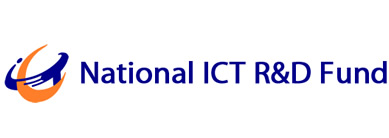





With a vision "To transform Pakistan’s economy into knowledge based economy by promoting efficient, sustainable and effective ICT initiatives through synergic development of industrial and academic resources."
With the huge number of internet users these days, live TV and video delivery over the internet is becoming more and more popular. Internet based video delivery systems are traditionally unicast in nature. In these systems each viewer connects directly to the video server (source) and requests transmission of the video. These systems thus put a great burden on video servers. In addition, due to the nature of the internet, packets are regularly lost which results in delays and jitters in the playback of the video at the client side. This directly impacts the quality of experience of the viewer. Therefore, the real time transmission of video to the viewers is a challenging task. To overcome the drawbacks of the unicast systems, P2P systems have gained wide attention recently
In P2P based video streaming, different peers cooperate with each other to receive the video as depicted in Figure 2b-1. The contributing peers form an overlay topology for content distribution. The video source chops the video contents into small size chunks, which are then injected into the network and are distributed using underlying streaming architecture. The objective of P2P based video streaming is the delivery of video contents to all the participating peers in a timely manner. As the video being transmitted is live therefore, it has more stringent delay requirements then normal file sharing or video on demand application
P2P streaming networks do not depend on dedicated network infrastructure, which facilitates its rapid and cost effective deployment. The burden on the video server can be reduced drastically in P2P systems by exploiting the computational resources and upload bandwidth of the participating peers. In this sort of approach each peer exchanges the video contents it has received with its neighbors, thereby ensuring that each peer receives the video. Therefore, the P2P streaming approach is able to cope with the need for high scalability over heterogeneous networks and presents itself as an attractive candidate for mass scale video content distribution over the internet.
The recent convergence of the communication and computing industries has resulted in the development of various consumer electronic devices, such as smart phones, smart TVs, gaming consoles and tablets. With the emergence of these new generations of devices, video playback and its quality has become key driving factor leading to their development. The transformation of these devices with various functions, such as video conferencing, video gaming, social networking and video continent distribution has resulted in the creation of heterogeneous networking environment, where different users use different type of devices to communicate with each other.
Live video distribution in the developed countries over the internet is already a successful business. This business is growing day-by- day with the addition of thousands of new viewers. The networking conditions of developed and developing countries are quite different, as the bandwidth available to end users is much lower and the links are often more unreliable. Furthermore, with the acute power shortage faced in Pakistan, the conventional video streaming architectures employed in the developed countries are not robust enough to cope with the highly unreliable and fragile nature of Pakistani internet connections. The combined impact of unreliable internet connections and frequent power outages result in users being regularly forced to leave and rejoin the network. This effect is called peer churning. This results in disconnecting other neighboring users, which are receiving the video through this peer (user). We thus intend to develop a tailor made live video distribution system for Pakistan. The tailor made live video distribution solution will be designed with these factors in mind. The specific features we intend to incorporate include enhanced robustness to peer churning, efficient peer selection and content distribution strategies.
A prime example which highlights the need for development of new architectures for developing countries is the BitMate algorithm. This algorithm has been developed by Prof. Umar Saif and his team for file sharing. It has received numerous national and international accolades for its utility in developing countries [2]. BitMate has been proven to be very successful in developing countries, where it has helped to significantly improve the quality of experience of low bandwidth users. The development of such algorithms which are optimized w.r.t the networking conditions of developing countries, result in considerably superior performance compared to the solutions optimized w.r.t the networking conditions of developed countries. Therefore, it is necessary that video streaming solutions optimized w.r.t the networking conditions of the developing countries be also developed.
As the existing streaming solutions that have been deployed so far are proprietary in nature, they cannot be modified w.r.t the networking conditions of Pakistan. This also hampers research and development activities geared towards making enhancements to these solutions. We thus propose the development STAMP, an open source modular P2P streaming system optimized for the networking conditions of Pakistan. STAMP will have inbuilt support scalability and heterogeneity. Scalability in the context of STAMP refers to both scalability in terms of support for accommodating any number of users on the fly and also scalability in terms of support for the simultaneous transmission of different video quality levels. The provision for the simultaneous transmission of multiple video quality levels has not been investigated so far. This support is specially needed in Pakistan where different users can have substantially different bandwidths available. Therefore, if a user is not able to stream a high quality version of the video due to bandwidth constraints, he is still able to download a low quality version of the same video.
As the software developed will be a well-documented open source modular system, therefore it will facilitate both academia and industry professionals for making enhancements, research contributions and rapid prototyping for commercial release. After the commercial release of this software, the media industry and TV channels of Pakistan will be able to utilize it for their large scale content distribution. Therefore, the intended beneficiaries of STAMP are researchers, academia, software industry, media industry and Pakistani citizens.
The major academic objectives of this project are as follows:
To develop a modular open source prototype for P2P based video streaming system, which will help software industry in the quick development and deployment of their product.
Dr.Nasru Minallah
Assistant Professor
Department of Computer Systems Engineering
University of Engineering and Technology Peshawar
Email: n.minallah@uetpeshawar.edu.pk
Contact: +92-3452757576